The AMD Ryzen Threadripper 3960X and 3970X Review: 24 and 32 Cores on 7nm
by Dr. Ian Cutress, Andrei Frumusanu & Gavin Bonshor on November 25, 2019 9:05 AM ESTCPU Performance: Encoding Tests
With the rise of streaming, vlogs, and video content as a whole, encoding and transcoding tests are becoming ever more important. Not only are more home users and gamers needing to convert video files into something more manageable, for streaming or archival purposes, but the servers that manage the output also manage around data and log files with compression and decompression. Our encoding tasks are focused around these important scenarios, with input from the community for the best implementation of real-world testing.
All of our benchmark results can also be found in our benchmark engine, Bench.
Handbrake 1.1.0: Streaming and Archival Video Transcoding
A popular open source tool, Handbrake is the anything-to-anything video conversion software that a number of people use as a reference point. The danger is always on version numbers and optimization, for example the latest versions of the software can take advantage of AVX-512 and OpenCL to accelerate certain types of transcoding and algorithms. The version we use here is a pure CPU play, with common transcoding variations.
We have split Handbrake up into several tests, using a Logitech C920 1080p60 native webcam recording (essentially a streamer recording), and convert them into two types of streaming formats and one for archival. The output settings used are:
- 720p60 at 6000 kbps constant bit rate, fast setting, high profile
- 1080p60 at 3500 kbps constant bit rate, faster setting, main profile
- 1080p60 HEVC at 3500 kbps variable bit rate, fast setting, main profile
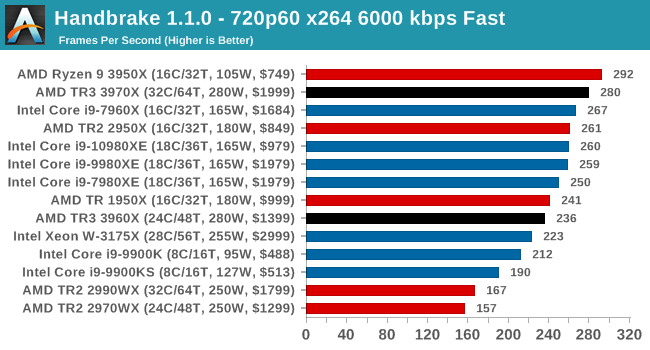
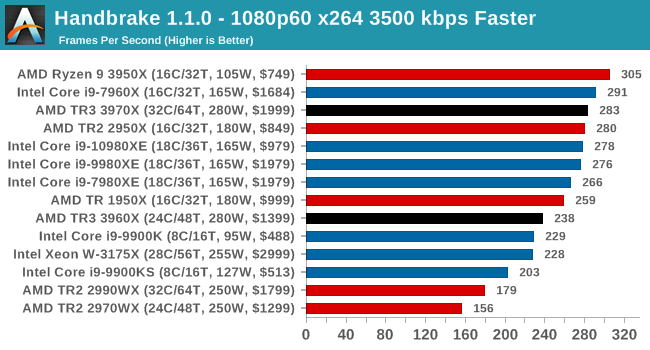

Video encoding is a little varied, based on the variable threaded nature. Certain encoding tests can be more memory sensitive here, or accelerated in different ways, or not scale well with more cores. Either way, TR3 performs a lot better than TR2, but the 3950X seems the best choice.
7-zip v1805: Popular Open-Source Encoding Engine
Out of our compression/decompression tool tests, 7-zip is the most requested and comes with a built-in benchmark. For our test suite, we’ve pulled the latest version of the software and we run the benchmark from the command line, reporting the compression, decompression, and a combined score.
It is noted in this benchmark that the latest multi-die processors have very bi-modal performance between compression and decompression, performing well in one and badly in the other. There are also discussions around how the Windows Scheduler is implementing every thread. As we get more results, it will be interesting to see how this plays out.
Please note, if you plan to share out the Compression graph, please include the Decompression one. Otherwise you’re only presenting half a picture.
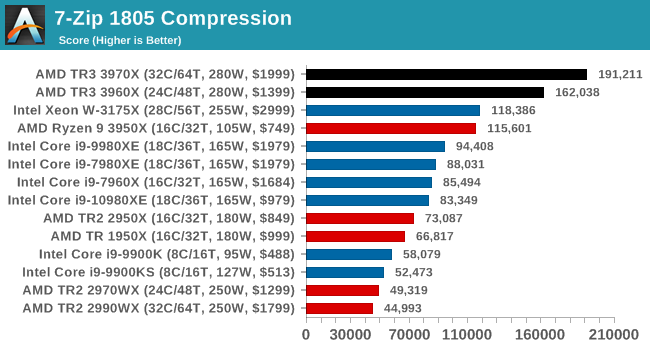
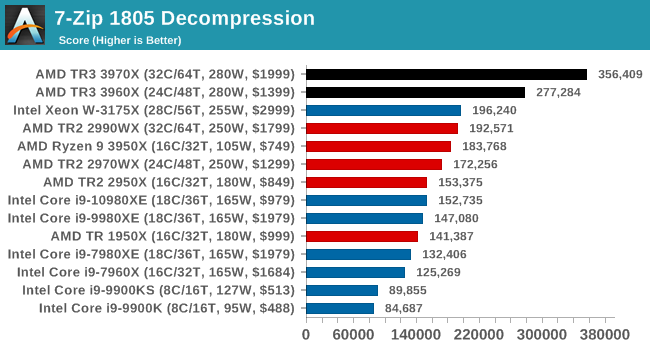
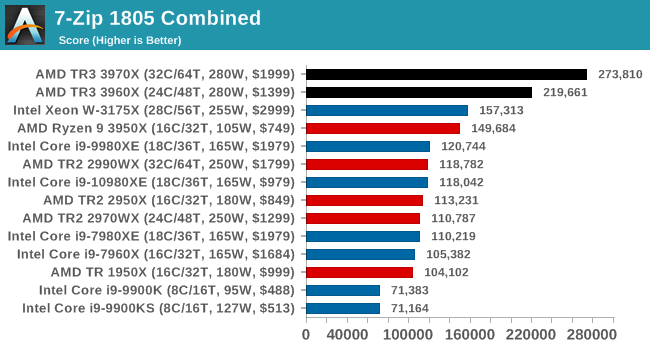
Easily parallel puts the TR3 well ahead of TR2 and Intel.
WinRAR 5.60b3: Archiving Tool
My compression tool of choice is often WinRAR, having been one of the first tools a number of my generation used over two decades ago. The interface has not changed much, although the integration with Windows right click commands is always a plus. It has no in-built test, so we run a compression over a set directory containing over thirty 60-second video files and 2000 small web-based files at a normal compression rate.
WinRAR is variable threaded but also susceptible to caching, so in our test we run it 10 times and take the average of the last five, leaving the test purely for raw CPU compute performance.
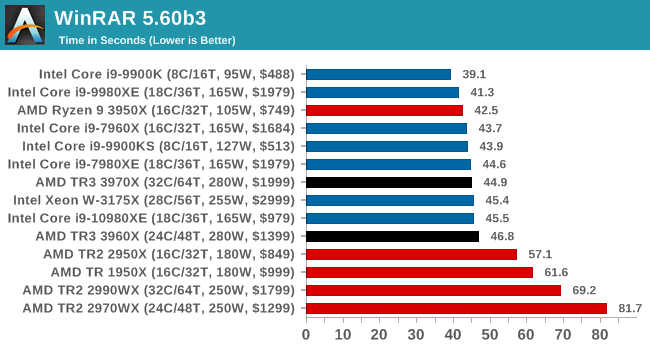
WinRAR is a variably threaded application, and both TR3 processors perform in the same ballpark as anything from Intel. Ideally we should have seen them streak ahead, but we seem to be at a point where CPU frequency or core counts are the limiting factor. At least with Zen 2, there are no issues as there was with Zen 1/Zen+.
AES Encryption: File Security
A number of platforms, particularly mobile devices, are now offering encryption by default with file systems in order to protect the contents. Windows based devices have these options as well, often applied by BitLocker or third-party software. In our AES encryption test, we used the discontinued TrueCrypt for its built-in benchmark, which tests several encryption algorithms directly in memory.
The data we take for this test is the combined AES encrypt/decrypt performance, measured in gigabytes per second. The software does use AES commands for processors that offer hardware selection, however not AVX-512.











245 Comments
View All Comments
melgross - Tuesday, November 26, 2019 - link
What you’re missing is that I’m talking about most users. The ones you mention are in very small numbers. There’s about a billion Windows machines out there, well under 1% need 16 or more cores. That still millions, but it’s not enough to move the market.What been one of the biggest problems involving pc sales the past year? Intel not producing enough chips. Not AMD. AMD is almost an afterthought. Most vendors and customers don’t want AND. Most pc users have never even heard of and. It’s why the are cheaper, and make little profit. They sell on price. And they’re trying to move in a market Intel isn’t very interested in—yet.
Xyler94 - Tuesday, November 26, 2019 - link
Most people just need their ARM powered cell phones these days, if you really want to get down to reality. light web browsing, posting on Facebook, sending an IM on messenger, potentially watching YouTube. All things that can be done off a cellphone. For those who need a bigger display, laptops are a good choice, but see little use outside of a few instances where a bigger screen is necessary.maxxbot - Tuesday, November 26, 2019 - link
And it's a continuously moving target too, just a few years ago people would say 8 cores is way more than necessary, now it's a baseline.mdriftmeyer - Tuesday, November 26, 2019 - link
Yes they do Mel. You just don't seem to know it. When Zen 3 get AVX 512 Apple has no more need of Intel, period. Mac Pro down to Macbook Air can be replaced w/ superior low power, higher performance per watt, lower priced CPUs to match RDNA 2.0 GPGPUs.xrror - Tuesday, November 26, 2019 - link
About the too much power... it might be that nobody is saying anything because if you fully load the processor with a workload where it draws it's full 300w.......it means that it's performing a workload that a few years prior would have required 4 separate machines at full tilt to match, and I'm pretty sure that 4 older gen HEDT rigs running full tilt is going to be drawing something significantly more than 300w overall in CPU power, let alone the rest of the rigs.
Korguz - Wednesday, November 27, 2019 - link
that is not what it means....beggerking@yahoo.com - Monday, November 25, 2019 - link
you forgot virtualization. now people can run virtualized environment for casual things such as file server, media server, backups, scheduler server, and even host their own websites.Dug - Monday, November 25, 2019 - link
You forgot the cost of virtualization if using Windows. They charge per core now, not per processor.Alistair - Tuesday, November 26, 2019 - link
The cost per core is a bit problem for AMD. Company just bought 3 x Epyc servers, and the much lower price was blunted by the per core licensing. Microsoft is effectively supporting Intel unintentionally... would rather they charge based on the MSRP of the CPU or something...Alistair - Tuesday, November 26, 2019 - link
big